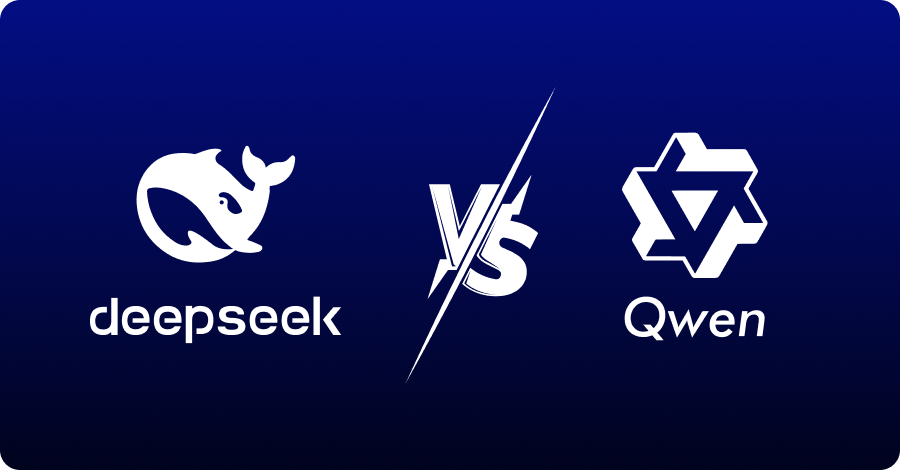DeepSeek vs. Qwen: A Detailed Analysis With Versions
- February 6, 2025
- 8 mins read
- Listen

Table of Content
The AI world is in quite a frenzy, as January was an extremely eventful month. DeepSeek made its mark in the world with its revolutionary open-source R1 model, while Alibaba’s Qwen has a new version out called Qwen 2.5 Max.
DeepSeek and Qwen seem to be gunning for the title of “Best AI Model” at this point, given how both releases were days apart. Based on some testing and early reviews, it seems both Qwen 2.5 and DeepSeek V3 are doing very well.
Hence, let’s compare the two AI platforms and see what is the best AI model currently available in the market.
An Overview of DeepSeek and Qwen
Before we start with the comparisons of DeepSeek and Qwen, let’s give a bit of an overview of both AI chatbots.
DeepSeek is a company that is the talk of the town after it released its R1 model. Utilizing DeepSeek V3 and R1, their chatbot has ascended to new heights, capable of outperforming any other AI platform in the market.
On the other hand, Qwen has been a mainstay in the AI world for a while, despite not being as well-known as its competitors. Created by Alibaba, Qwen has been steadily improving over the years, with Qwen 2.5 Max reportedly outperforming DeepSeek V3 and OpenAI GPT 4o.
The interesting fact about both DeepSeek and Qwen is that both have come out with new versions in January, within days of each other. So, let’s compare DeepSeek V3 and Qwen 2.5 Max and see which one reigns supreme.
Learn more: What is DeepSeek & How does it Work?
Differences Between DeepSeek and Qwen
Let’s start off with a comparison table of DeepSeek and Qwen in terms of architecture, performance, and pricing.
|
DeepSeek |
Qwen | |
|
Popular Models |
DeepSeek V3 DeepSeek R1 Janus Pro 7-B (On Hugging Face) |
Qwen 2.5 Max Qwen 2.5 VL 72B Instruct |
|
Architecture |
Uses Mixture of Experts (MoE) and Reinforcement Learning (RL) |
Uses Mixture of Experts (MoE) |
|
Reasoning Model |
DeepSeek R1 |
Has no Reasoning Model |
|
Performance In Tasks |
More Technical and Detail-Oriented |
More Versatile |
|
Scalability |
Limited Scalability |
Highly Scalable |
|
Sourcing Policy |
Open-Source (R1 and Janus Pro 7B) |
Older Qwen Models: Open-Source New Models: Closed-Source |
|
API Pricing (per million tokens) |
Input: $0.55 Output: $2.19 |
Input: $1.6 Output: $6.4 |
As the table above shows, both DeepSeek and Qwen have many available models. For DeepSeek, their R1 model has received a lot of acclaim for being adept at handling mathematical and technical tasks. Their latest Janus Pro 7B has shown a lot of promise for multimodal capabilities.
Meanwhile, Qwen has their latest 2.5 Max, which is seemingly outperforming the likes of DeepSeek V3 and Open AI’s 4o. Also, their 2.5 VL 72B Instruct shows a good image generation process.
Architecture
DeepSeek focuses on using Mixture of Experts (MoE) and Reinforcement Learning (RL). Through RL, DeepSeek models are capable of learning about certain topics through content, adapting their knowledge base over time. This means DeepSeek’s responses and solutions improve as they learn more information through user interaction
Qwen, on the other hand, is based on a Mixture of Experts, but their data is pre-trained. So, there is no adaptive learning mechanism when it comes to any of Qwen’s models at this moment. However, Qwen does offer processes like fine-tuning to improve certain knowledge gaps the model may have.
Performance in Tasks
In terms of performance, both DeepSeek and Qwen have different strong points. Hence, for different tasks, one model is better than the other.
For Text Generation
DeepSeek generates technical and detailed responses when asked questions. For topics related to mathematics, reports, and such, DeepSeek can provide some insightful content. However, they lack versatility in terms of topical coverage, as DeepSeek is better at certain categories than others.
Qwen is a more general-purpose model in this regard. Its versatility is very apparent when you start asking the AI different types of questions. Also, their generated content is focused on being creative and more thought-provoking than DeepSeek. While Qwen does provide details in its content, it is still lacking compared to DeepSeek.
For Coding and Technical Tasks
DeepSeek excels in this category, as the R1 model is designed to be excellent for coding and technical tasks. The code they create is efficient and is explained at the end. Also, when posed mathematical questions, DeepSeek resolves them by providing an extensive solution.
Qwen is also no slouch in this area, but it does not exactly perform as well as DeepSeek does. It is capable of generating code in any programming language and also solves technical questions quite well. However, the solutions are not optimized in some instances.
For Image and Video
DeepSeek’s latest Janus Pro 7B shows some promise in this regard. Through this model, DeepSeek will be able to generate images and video with ease. However, it is not available at DeepSeek Chat at the moment, and you can only find it in Hugging Face as an open-source model.
Qwen’s 2.5 Max is really good at this front as it supports multimodal capabilities. With Qwen 2.5 Max, you can generate an image through prompts or by providing a document. Furthermore, the Qwen 2.5 VL 72B Instruct allows users to break down images and explain them in text. At this moment, no Qwen model has video generation capabilities.
Scalability
Qwen is more scalable than DeepSeek, and there are two reasons for that. The first of which is that Qwen is designed to handle high volumes of queries for large-scale industries. Through Alibaba Cloud, Qwen can seamlessly be integrated into any business. DeepSeek is more suited for specialized use cases, so smaller deployments suit their AI models.
Secondly, Qwen’s knowledge base is more versatile than DeepSeek’s. Hence, Qwen can handle any type of query at any given point. Thus, due to a lack of a deep knowledge base and optimization in terms of business, DeepSeek is a little lacking compared to Qwen.
Cost and API Pricing
As for pricing, DeepSeek is cheaper than Qwen in terms of training and API integration. Another advantage of DeepSeek is that its latest models are all open-source, whereas Qwen 2.5 in particular is not open-source.
However, you can use both for free on their chatbot platforms. Hardware efficiency is also higher for DeepSeek, as their models are tailored to not need much computational power. So, DeepSeek is a more cost-efficient model that you can use at lower costs.
Learn more: DeepSeek vs ChatGPT: How Do They Compare?
Advantages and Disadvantages of DeepSeek and Qwen
DeepSeek and Gwen have some advantages and disadvantages of their own. Here they are as follows:.
DeepSeek
|
Advantages |
Disadvantages |
|
Top-Notch for Specialized Tasks |
Less Versatile as a Model |
|
Learns Through Interactions Continuously |
Requires Technical Knowledge to Use for Businesses |
|
Open Source Models With Cheap API Pricing |
Cannot Answer or Solve Certain Queries |
As the table shows, DeepSeek models are more aligned to solve specialized tasks and improve their knowledge base through Reinforcement Learning (RL). Also, its cost-efficient models allow businesses to implement AI with fewer expenses, getting more value in return.
However, DeepSeek is not diverse enough to handle all queries and requires some technical know-how, especially when implementing their open-source models.
Qwen
|
Advantages |
Disadvantages |
|
Versatile and Diverse Knowledge Base |
Lacking in terms of Specialized Topics |
|
Highly Scalable for Businesses |
Latest Models are not Open-Source |
|
Ability to Fine-Tune For Specific Use Cases |
Does not Always Give Optimized Solutions |
Qwen’s ability to provide creative solutions using its diverse information base is a huge boon. Also, their models can handle large amounts of queries, making them more scalable for businesses. Overall, their ability to provide general-purpose answers makes the models more desirable.
However, its versatility makes it lacking in terms of depth of information for many niche topics. Also, the costs to implement Qwen are higher, and it is not always the best at technical queries.
Which Model to Use?
In terms of when to use either DeepSeek or Qwen, it depends on your use cases. Here are the situations when you should use either platform.
When to Use DeepSeek?
DeepSeek is best for:
- Cost-Efficiency: DeepSeek’s open-source models and lower API pricing make their products more cost-effective for businesses.
- Technical Solutions: DeepSeek is adept at coding and mathematical queries; hence, it is better suited for these use cases.
- Comprehensive Solution: DeepSeek provides more details in their solutions that help with technical documentation and creating reports.
When to Use Qwen?
Qwen is best for:
- Diverse and Versatile Solutions: Qwen is excellent for answering queries for a huge number of topics.
- Scalability: Qwen is built to serve large-scale industries; hence, their models are more scalable than other products in the market.
- Fine-Tuning: Qwen can be fine-tuned to fill up knowledge gaps for specific use cases.
Learn more: DeepSeek Use Cases for Businesses
Key Takeaways
Qwen and DeepSeek are both excellent solutions, especially with their new models (2.5 Max and R1, respectively). Thus, choosing either AI platform based on usage is the best way to go about it.
DeepSeek is a more specialized solution for technical queries and the like, while Qwen is more general-purpose. Also, Qwen is more suited for businesses due to its scalability as opposed to DeepSeek.
Lastly, DeepSeek is more cost-effective due to its lightweight nature. Hence, both models are great to use, provided you know what you need out of an AI chatbot.
Frequently Asked Questions
DeepSeek is an advanced AI language model developed by a Chinese tech startup based in Hangzhou. It is known for its strong reasoning capabilities, making it suitable for complex problem-solving applications. DeepSeek is often used in fields that require detailed analysis and deep understanding of context.
Qwen is a family of AI language models developed by Alibaba. It is designed to handle a wide range of tasks, from natural language processing to multimodal AI functionalities. Qwen is open-source and offers flexibility for various applications, with different versions ranging in size from smaller models to more powerful, larger versions.
The key differences between DeepSeek and Qwen lie in their focus and capabilities:
- DeepSeek excels in reasoning-heavy tasks, ideal for problem-solving and complex data analysis.
- Qwen, on the other hand, provides a broader range of models, including smaller and larger versions, making it versatile for general-purpose tasks such as chatbots, content generation, and image processing.
While Qwen and DeepSeek are both powerful AI models, their strengths differ. Qwen is recognized for its generalization capabilities across various tasks, while DeepSeek stands out for its deep reasoning and analysis. Whether one is “better” depends on the specific use case. For complex, reasoning-based applications, DeepSeek may be more effective, whereas Qwen excels in versatility and multimodal tasks.
DeepSeek has received significant attention due to its recent emergence and advanced reasoning capabilities. Its ability to solve complex problems has caught the spotlight, especially among those interested in AI applications that require deep analysis. This novelty factor, along with its impressive performance in specialized tasks, contributes to its growing prominence.
DeepSeek’s affordability is attributed to the efficient use of resources by its developers. Its pricing strategy makes it accessible to a broader audience while providing powerful features, making it an attractive option for businesses looking for advanced AI without the high costs associated with other models like GPT-based systems.
DeepSeek and Qwen are reshaping the AI landscape by offering alternatives to established models like GPT. These models provide competitive options for businesses, encouraging innovation in AI development. Their rise has prompted both domestic and international companies to accelerate their own AI research and development, enhancing overall market competition.



